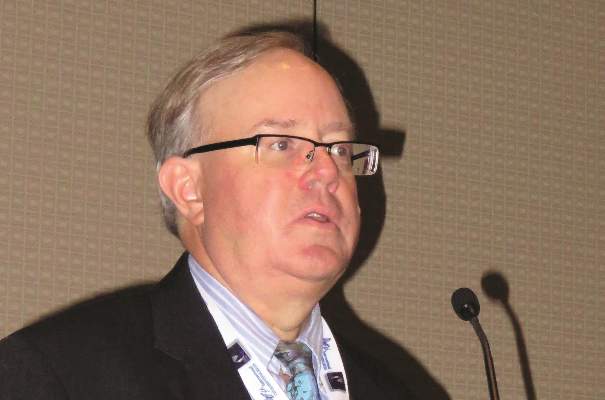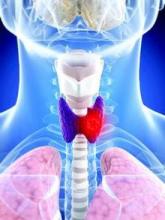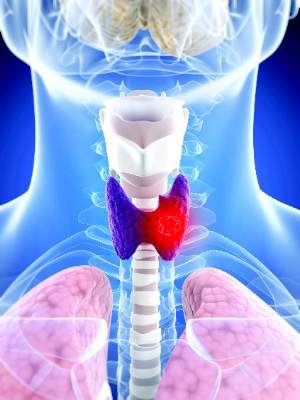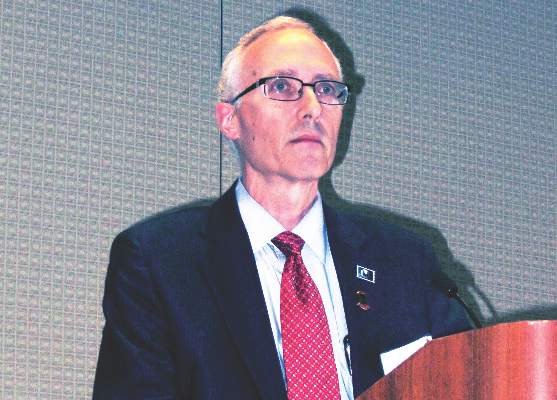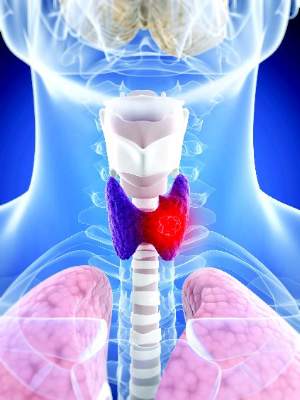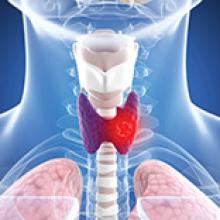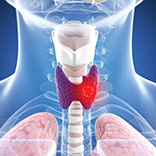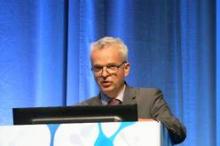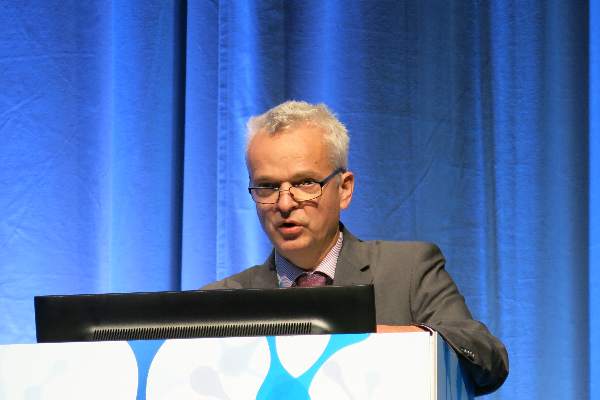User login
Thyroglobulin can’t predict pazopanib response in differentiated thyroid cancer
Lake BUENA VISTA, FLA. – Pazopanib is an effective therapy for advanced thyroid cancer, but at present, there seems to be no way to predict which patients will respond to it.
An investigation into the predictive value of thyroglobulin found that the level during treatment did change, but it did so in parallel with response; there was no way to use the protein to parse out which patients would do well, Dr. Keith Bible said at the International Thyroid Congress.
“We had hoped that it might be a predictor as early as 4 weeks, so we could assign patients into categories of response and perhaps stop treatment earlier,” said Dr. Bible of the Mayo Clinic, Rochester, Minn. “Unfortunately, there was no way to do that.”
Pazopanib (Votrient) is a tyrosine kinase inhibitor of vascular endothelial growth factor receptors. It is approved for advanced soft tissue sarcoma and advanced renal cell carcinoma. The Mayo Clinic Consortium has been investigating pazopanib in phase II trials for advanced differentiated and medullary thyroid cancers. In a 2010 report, it was shown to induce at least a partial response in about half of the patients who received it (Lancet Oncol. 2010 Oct;11[10]:962-72).
Last year, it was also shown to be effective in advanced medullary thyroid cancer. Five of 35 patients attained partial Response Evaluation Criteria In Solid Tumors (RECIST) responses (14%) (J Clin Endocrinol Metab. 2014 May;99[5]:1687-93).
The drug has not been successful in treating advanced anaplastic thyroid cancer, however.
Because of pazopanib’s proclivity to induce sometimes-severe hypertension, investigators were hoping for some way to stratify potential responders. Thyroglobulin levels could be one marker, Dr. Bible said at the meeting, which was held by the American Thyroid Association, Asia-Oceania Thyroid Association, European Thyroid Association, and Latin American Thyroid Society.
He and the consortium investigators examined how thyroglobulin levels correlated with RECIST scores in 60 patients with metastatic differentiated thyroid cancers. The patients received a median of 10 cycles, but the range was wide (1-53 cycles). Most of them (92%) had already received systemic therapy, including a tyrosine kinase inhibitor and/or radioactive iodine.
The most common side effect was hypertension, which occurred in 75% patients, and was severe in 23%. Of those with a severe reaction, 53% required a new prescription for an antihypertensive medication. No one left the study or required a pazopanib dose reduction because of a blood pressure elevation, however. “We responded with a aggressive treatment, but it was a prominent issue,” Dr. Bible said.
Other adverse events were fatigue (83%; 8% severe); decrease in neutrophils (47%; 8% severe); diarrhea (78%; 7% severe); hand-foot syndrome (17%; 7% severe); and elevations of liver enzymes (53%; 6% severe). There were no deaths related to the study drug.
Partial RECIST responses occurred in 22 patients (37%). Thyroglobulin change did not differ by response after cycle 1, although its nadir was lower among patients who attained a partial response than among those who maintained disease stability (–87% vs. –69%).
“There was this correlation of nadir with maximum RECIST response, but this occurred in parallel with the response, so it was not capable of providing a prediction of response,” Dr. Bible said.
Prior therapy also was not a response predictor, he added.
Genomic profiling was available for 16 patients; of these, 11 had mutations of BRAF, p53, JAK3 or HRAS. Thyroglobulin change and response to treatment was not significantly correlated with any of these mutations. Nor did it correlate with any type of prior tumor therapy.
The finding that pazopanib can benefit patients previously treated with a kinase inhibitor is an interesting one, Dr. Bible noted.
“Most kinase inhibitors are very promiscuous – they work on a number of pathways and have a footprint which is very messy. Most of them seem to have some activity in differentiated thyroid cancer, but we are still struggling to understand how that footprint varies. In theory they are all targeting VEGF receptors, but it’s striking that we can go from one kinase inhibitor to the next and still get a response.”
Dr. Bible had no financial declarations.
On Twitter @Alz_Gal
Lake BUENA VISTA, FLA. – Pazopanib is an effective therapy for advanced thyroid cancer, but at present, there seems to be no way to predict which patients will respond to it.
An investigation into the predictive value of thyroglobulin found that the level during treatment did change, but it did so in parallel with response; there was no way to use the protein to parse out which patients would do well, Dr. Keith Bible said at the International Thyroid Congress.
“We had hoped that it might be a predictor as early as 4 weeks, so we could assign patients into categories of response and perhaps stop treatment earlier,” said Dr. Bible of the Mayo Clinic, Rochester, Minn. “Unfortunately, there was no way to do that.”
Pazopanib (Votrient) is a tyrosine kinase inhibitor of vascular endothelial growth factor receptors. It is approved for advanced soft tissue sarcoma and advanced renal cell carcinoma. The Mayo Clinic Consortium has been investigating pazopanib in phase II trials for advanced differentiated and medullary thyroid cancers. In a 2010 report, it was shown to induce at least a partial response in about half of the patients who received it (Lancet Oncol. 2010 Oct;11[10]:962-72).
Last year, it was also shown to be effective in advanced medullary thyroid cancer. Five of 35 patients attained partial Response Evaluation Criteria In Solid Tumors (RECIST) responses (14%) (J Clin Endocrinol Metab. 2014 May;99[5]:1687-93).
The drug has not been successful in treating advanced anaplastic thyroid cancer, however.
Because of pazopanib’s proclivity to induce sometimes-severe hypertension, investigators were hoping for some way to stratify potential responders. Thyroglobulin levels could be one marker, Dr. Bible said at the meeting, which was held by the American Thyroid Association, Asia-Oceania Thyroid Association, European Thyroid Association, and Latin American Thyroid Society.
He and the consortium investigators examined how thyroglobulin levels correlated with RECIST scores in 60 patients with metastatic differentiated thyroid cancers. The patients received a median of 10 cycles, but the range was wide (1-53 cycles). Most of them (92%) had already received systemic therapy, including a tyrosine kinase inhibitor and/or radioactive iodine.
The most common side effect was hypertension, which occurred in 75% patients, and was severe in 23%. Of those with a severe reaction, 53% required a new prescription for an antihypertensive medication. No one left the study or required a pazopanib dose reduction because of a blood pressure elevation, however. “We responded with a aggressive treatment, but it was a prominent issue,” Dr. Bible said.
Other adverse events were fatigue (83%; 8% severe); decrease in neutrophils (47%; 8% severe); diarrhea (78%; 7% severe); hand-foot syndrome (17%; 7% severe); and elevations of liver enzymes (53%; 6% severe). There were no deaths related to the study drug.
Partial RECIST responses occurred in 22 patients (37%). Thyroglobulin change did not differ by response after cycle 1, although its nadir was lower among patients who attained a partial response than among those who maintained disease stability (–87% vs. –69%).
“There was this correlation of nadir with maximum RECIST response, but this occurred in parallel with the response, so it was not capable of providing a prediction of response,” Dr. Bible said.
Prior therapy also was not a response predictor, he added.
Genomic profiling was available for 16 patients; of these, 11 had mutations of BRAF, p53, JAK3 or HRAS. Thyroglobulin change and response to treatment was not significantly correlated with any of these mutations. Nor did it correlate with any type of prior tumor therapy.
The finding that pazopanib can benefit patients previously treated with a kinase inhibitor is an interesting one, Dr. Bible noted.
“Most kinase inhibitors are very promiscuous – they work on a number of pathways and have a footprint which is very messy. Most of them seem to have some activity in differentiated thyroid cancer, but we are still struggling to understand how that footprint varies. In theory they are all targeting VEGF receptors, but it’s striking that we can go from one kinase inhibitor to the next and still get a response.”
Dr. Bible had no financial declarations.
On Twitter @Alz_Gal
Lake BUENA VISTA, FLA. – Pazopanib is an effective therapy for advanced thyroid cancer, but at present, there seems to be no way to predict which patients will respond to it.
An investigation into the predictive value of thyroglobulin found that the level during treatment did change, but it did so in parallel with response; there was no way to use the protein to parse out which patients would do well, Dr. Keith Bible said at the International Thyroid Congress.
“We had hoped that it might be a predictor as early as 4 weeks, so we could assign patients into categories of response and perhaps stop treatment earlier,” said Dr. Bible of the Mayo Clinic, Rochester, Minn. “Unfortunately, there was no way to do that.”
Pazopanib (Votrient) is a tyrosine kinase inhibitor of vascular endothelial growth factor receptors. It is approved for advanced soft tissue sarcoma and advanced renal cell carcinoma. The Mayo Clinic Consortium has been investigating pazopanib in phase II trials for advanced differentiated and medullary thyroid cancers. In a 2010 report, it was shown to induce at least a partial response in about half of the patients who received it (Lancet Oncol. 2010 Oct;11[10]:962-72).
Last year, it was also shown to be effective in advanced medullary thyroid cancer. Five of 35 patients attained partial Response Evaluation Criteria In Solid Tumors (RECIST) responses (14%) (J Clin Endocrinol Metab. 2014 May;99[5]:1687-93).
The drug has not been successful in treating advanced anaplastic thyroid cancer, however.
Because of pazopanib’s proclivity to induce sometimes-severe hypertension, investigators were hoping for some way to stratify potential responders. Thyroglobulin levels could be one marker, Dr. Bible said at the meeting, which was held by the American Thyroid Association, Asia-Oceania Thyroid Association, European Thyroid Association, and Latin American Thyroid Society.
He and the consortium investigators examined how thyroglobulin levels correlated with RECIST scores in 60 patients with metastatic differentiated thyroid cancers. The patients received a median of 10 cycles, but the range was wide (1-53 cycles). Most of them (92%) had already received systemic therapy, including a tyrosine kinase inhibitor and/or radioactive iodine.
The most common side effect was hypertension, which occurred in 75% patients, and was severe in 23%. Of those with a severe reaction, 53% required a new prescription for an antihypertensive medication. No one left the study or required a pazopanib dose reduction because of a blood pressure elevation, however. “We responded with a aggressive treatment, but it was a prominent issue,” Dr. Bible said.
Other adverse events were fatigue (83%; 8% severe); decrease in neutrophils (47%; 8% severe); diarrhea (78%; 7% severe); hand-foot syndrome (17%; 7% severe); and elevations of liver enzymes (53%; 6% severe). There were no deaths related to the study drug.
Partial RECIST responses occurred in 22 patients (37%). Thyroglobulin change did not differ by response after cycle 1, although its nadir was lower among patients who attained a partial response than among those who maintained disease stability (–87% vs. –69%).
“There was this correlation of nadir with maximum RECIST response, but this occurred in parallel with the response, so it was not capable of providing a prediction of response,” Dr. Bible said.
Prior therapy also was not a response predictor, he added.
Genomic profiling was available for 16 patients; of these, 11 had mutations of BRAF, p53, JAK3 or HRAS. Thyroglobulin change and response to treatment was not significantly correlated with any of these mutations. Nor did it correlate with any type of prior tumor therapy.
The finding that pazopanib can benefit patients previously treated with a kinase inhibitor is an interesting one, Dr. Bible noted.
“Most kinase inhibitors are very promiscuous – they work on a number of pathways and have a footprint which is very messy. Most of them seem to have some activity in differentiated thyroid cancer, but we are still struggling to understand how that footprint varies. In theory they are all targeting VEGF receptors, but it’s striking that we can go from one kinase inhibitor to the next and still get a response.”
Dr. Bible had no financial declarations.
On Twitter @Alz_Gal
AT ITC 2015
Key clinical point: Falling thyroglobulin levels cannot predict early response to pazopanib in differentiated thyroid cancers.
Major finding: There was a 37% response rate for patients taking pazopanib for differentiated thyroid cancer, but thyroglobulin decline was not an early predictor of response.
Data source: A prospective study of 60 patients.
Disclosures: Dr. Bible had no financial disclosures.
Cabozantinib shows promise in refractory differentiated thyroid cancer
LAKE BUENA VISTA, FLA. – Most patients with differentiated thyroid cancer who had shown progression on previous courses of targeted chemotherapy either maintained stable disease or responded to the oral multikinase inhibitor cabozantinib (Cometriq), according to a small multicenter phase II trial presented at the International Thyroid Congress.
This is important, according to Dr. Manisha H. Shah, because there has been no standard of care for patients with differentiated thyroid cancer whose cancer progresses on first- or second-line vascular endothelial growth factor receptor (VEGFR) inhibitors.
Nine of the 25 enrolled patients (36%; 95% confidence interval, 18%-57%) showed confirmed partial response, 12 patients (48%) had stable disease, and one patient had disease progression, according to Dr. Shah, director of the neuroendocrine tumor program at Ohio State University’s Wexner Medical Center. The trial enrolled patients with radioiodine–refractory differentiated thyroid cancer who had progression of their disease after one or two previous VEGFR agents.
Cabozantinib targets VEGFR and MET and is approved as first-line treatment for medullary thyroid cancer. The majority of the response to cabozantinib occurs in the first several months of treatment, so the study used a Simon minimax two-stage design, enrolling an initial 16 patients, then opening enrollment to an additional 9 when at least 2 of the initial cohort showed partial or complete response within the first 6 months.
The primary outcome measure was the number of patients showing objective response (partial or complete response) within the first 6 months of therapy.
Median patient age was 64 years, and 64% of patients were male. Just over half of the patients previously had been treated with sorafenib, and just over a quarter had received pazopanib. Five patients had received two previous VEGFR-targeted therapies, while the remaining 20 had received one.
Nine patients (36%) had papillary thyroid cancer, seven (28%) had poorly differentiated thyroid cancer, five (20%) had Hurthle cell cancer, and four (16%) had follicular thyroid cancer. The most common metastasis sites were lymph node, bone, and lung.
Patients received continuous treatment until they showed disease progression, had an unacceptable adverse event or an illness precluding further treatment, or withdrew consent.
Disease progression was measured by serum tumor markers and CT or MRI scan every 8 weeks while in the study; patients also received bone scans and 18F-FDG and 18F-fluoride PET scans before the study and while in the study.
Side effects were common and generally mild, with two instances each of grade 3 events related to fatigue, hand-foot skin reactions, and diarrhea. One death occurred and was adjudicated as possibly study related; there were no grade 4 events, and no grade 3 bleeding events.
Dr. Shah noted that the starting cabozantinib dose of 60 mg/day was considerably lower than that used in previous trials for thyroid cancer. With time, investigators have learned that the sometimes debilitating side effects of cabozantinib are somewhat dose dependent, she noted. The study design permitted dose escalation to 80 mg for nonresponders to the lower dose, and permitted a decrease to 40 or 20 mg/day as needed to manage side effects. Investigators were able to tell the patients what to expect, and to be proactive in anticipating side effects. “We have learned to manage these drugs much better with time,” she said.
“Cabozantinib was effective in inducing a durable partial response,” said Dr. Shah. Future directions, in addition to phase III clinical trials, may include combining cabozantinib with immune checkpoint–targeted therapies such as lenvatinib, a strategy that has been effective for other cancers, she said at the meeting, which was held by the American Thyroid Association, Asia-Oceania Thyroid Association, European Thyroid Association, and Latin American Thyroid Society.
The multisite study was sponsored by the National Cancer Institute with participation by eight International Thyroid Oncology Group centers. Dr. Shah reported being on the advisory board for Exelixis and Eisai, and receiving research funding from those two organizations and Bayer.
On Twitter @karioakes
LAKE BUENA VISTA, FLA. – Most patients with differentiated thyroid cancer who had shown progression on previous courses of targeted chemotherapy either maintained stable disease or responded to the oral multikinase inhibitor cabozantinib (Cometriq), according to a small multicenter phase II trial presented at the International Thyroid Congress.
This is important, according to Dr. Manisha H. Shah, because there has been no standard of care for patients with differentiated thyroid cancer whose cancer progresses on first- or second-line vascular endothelial growth factor receptor (VEGFR) inhibitors.
Nine of the 25 enrolled patients (36%; 95% confidence interval, 18%-57%) showed confirmed partial response, 12 patients (48%) had stable disease, and one patient had disease progression, according to Dr. Shah, director of the neuroendocrine tumor program at Ohio State University’s Wexner Medical Center. The trial enrolled patients with radioiodine–refractory differentiated thyroid cancer who had progression of their disease after one or two previous VEGFR agents.
Cabozantinib targets VEGFR and MET and is approved as first-line treatment for medullary thyroid cancer. The majority of the response to cabozantinib occurs in the first several months of treatment, so the study used a Simon minimax two-stage design, enrolling an initial 16 patients, then opening enrollment to an additional 9 when at least 2 of the initial cohort showed partial or complete response within the first 6 months.
The primary outcome measure was the number of patients showing objective response (partial or complete response) within the first 6 months of therapy.
Median patient age was 64 years, and 64% of patients were male. Just over half of the patients previously had been treated with sorafenib, and just over a quarter had received pazopanib. Five patients had received two previous VEGFR-targeted therapies, while the remaining 20 had received one.
Nine patients (36%) had papillary thyroid cancer, seven (28%) had poorly differentiated thyroid cancer, five (20%) had Hurthle cell cancer, and four (16%) had follicular thyroid cancer. The most common metastasis sites were lymph node, bone, and lung.
Patients received continuous treatment until they showed disease progression, had an unacceptable adverse event or an illness precluding further treatment, or withdrew consent.
Disease progression was measured by serum tumor markers and CT or MRI scan every 8 weeks while in the study; patients also received bone scans and 18F-FDG and 18F-fluoride PET scans before the study and while in the study.
Side effects were common and generally mild, with two instances each of grade 3 events related to fatigue, hand-foot skin reactions, and diarrhea. One death occurred and was adjudicated as possibly study related; there were no grade 4 events, and no grade 3 bleeding events.
Dr. Shah noted that the starting cabozantinib dose of 60 mg/day was considerably lower than that used in previous trials for thyroid cancer. With time, investigators have learned that the sometimes debilitating side effects of cabozantinib are somewhat dose dependent, she noted. The study design permitted dose escalation to 80 mg for nonresponders to the lower dose, and permitted a decrease to 40 or 20 mg/day as needed to manage side effects. Investigators were able to tell the patients what to expect, and to be proactive in anticipating side effects. “We have learned to manage these drugs much better with time,” she said.
“Cabozantinib was effective in inducing a durable partial response,” said Dr. Shah. Future directions, in addition to phase III clinical trials, may include combining cabozantinib with immune checkpoint–targeted therapies such as lenvatinib, a strategy that has been effective for other cancers, she said at the meeting, which was held by the American Thyroid Association, Asia-Oceania Thyroid Association, European Thyroid Association, and Latin American Thyroid Society.
The multisite study was sponsored by the National Cancer Institute with participation by eight International Thyroid Oncology Group centers. Dr. Shah reported being on the advisory board for Exelixis and Eisai, and receiving research funding from those two organizations and Bayer.
On Twitter @karioakes
LAKE BUENA VISTA, FLA. – Most patients with differentiated thyroid cancer who had shown progression on previous courses of targeted chemotherapy either maintained stable disease or responded to the oral multikinase inhibitor cabozantinib (Cometriq), according to a small multicenter phase II trial presented at the International Thyroid Congress.
This is important, according to Dr. Manisha H. Shah, because there has been no standard of care for patients with differentiated thyroid cancer whose cancer progresses on first- or second-line vascular endothelial growth factor receptor (VEGFR) inhibitors.
Nine of the 25 enrolled patients (36%; 95% confidence interval, 18%-57%) showed confirmed partial response, 12 patients (48%) had stable disease, and one patient had disease progression, according to Dr. Shah, director of the neuroendocrine tumor program at Ohio State University’s Wexner Medical Center. The trial enrolled patients with radioiodine–refractory differentiated thyroid cancer who had progression of their disease after one or two previous VEGFR agents.
Cabozantinib targets VEGFR and MET and is approved as first-line treatment for medullary thyroid cancer. The majority of the response to cabozantinib occurs in the first several months of treatment, so the study used a Simon minimax two-stage design, enrolling an initial 16 patients, then opening enrollment to an additional 9 when at least 2 of the initial cohort showed partial or complete response within the first 6 months.
The primary outcome measure was the number of patients showing objective response (partial or complete response) within the first 6 months of therapy.
Median patient age was 64 years, and 64% of patients were male. Just over half of the patients previously had been treated with sorafenib, and just over a quarter had received pazopanib. Five patients had received two previous VEGFR-targeted therapies, while the remaining 20 had received one.
Nine patients (36%) had papillary thyroid cancer, seven (28%) had poorly differentiated thyroid cancer, five (20%) had Hurthle cell cancer, and four (16%) had follicular thyroid cancer. The most common metastasis sites were lymph node, bone, and lung.
Patients received continuous treatment until they showed disease progression, had an unacceptable adverse event or an illness precluding further treatment, or withdrew consent.
Disease progression was measured by serum tumor markers and CT or MRI scan every 8 weeks while in the study; patients also received bone scans and 18F-FDG and 18F-fluoride PET scans before the study and while in the study.
Side effects were common and generally mild, with two instances each of grade 3 events related to fatigue, hand-foot skin reactions, and diarrhea. One death occurred and was adjudicated as possibly study related; there were no grade 4 events, and no grade 3 bleeding events.
Dr. Shah noted that the starting cabozantinib dose of 60 mg/day was considerably lower than that used in previous trials for thyroid cancer. With time, investigators have learned that the sometimes debilitating side effects of cabozantinib are somewhat dose dependent, she noted. The study design permitted dose escalation to 80 mg for nonresponders to the lower dose, and permitted a decrease to 40 or 20 mg/day as needed to manage side effects. Investigators were able to tell the patients what to expect, and to be proactive in anticipating side effects. “We have learned to manage these drugs much better with time,” she said.
“Cabozantinib was effective in inducing a durable partial response,” said Dr. Shah. Future directions, in addition to phase III clinical trials, may include combining cabozantinib with immune checkpoint–targeted therapies such as lenvatinib, a strategy that has been effective for other cancers, she said at the meeting, which was held by the American Thyroid Association, Asia-Oceania Thyroid Association, European Thyroid Association, and Latin American Thyroid Society.
The multisite study was sponsored by the National Cancer Institute with participation by eight International Thyroid Oncology Group centers. Dr. Shah reported being on the advisory board for Exelixis and Eisai, and receiving research funding from those two organizations and Bayer.
On Twitter @karioakes
AT ITC 2015
Key clinical point: Cabozantinib shows promise for refractory differentiated thyroid cancer.
Major finding: Twenty-one of 25 patients with differentiated thyroid cancer showed stable disease or partial response to cabozantinib after disease progression on previous targeted therapies.
Data source: Multisite, open-label phase II clinical trial of 25 patients.
Disclosures: The study was sponsored by the National Cancer Institute with participation by eight International Thyroid Oncology Group centers. Dr. Shah reported being on the advisory board for Exelixis and Eisai, and receiving research funding from those two organizations and Bayer.
ITC 2015: TIRADS scoring helps sort out malignancy after fine-needle aspiration of thyroid nodule
LAKE BUENA VISTA, FLA. – A scoring system for ultrasound evaluation of thyroid nodules is useful in predicting malignancy in cases of atypia of unknown significance but is less useful for nodules categorized as follicular lesions of undetermined significance.
Dr. Jung Hyun Soon, a radiologist at Severance Hospital, Yonsei University, Seoul, presented these findings at the International Thyroid Congress.
The atypia of unknown significance (AUS) and follicular lesion of undetermined significance (FLUS) subcategories within the Bethesda cytopathology system carry a 5%-15% risk of malignancy. The Bethesda system for assessing fine-needle aspirate (FNA) helps to identify more precisely “the different patterns of atypia associated with higher malignancy risk, and to enable adequate malignancy risk stratification of thyroid nodules,” said Dr. Yoon.
Ultrasonography also contributes to the prediction of malignancy, and the Thyroid Imaging Reporting and Data System (TIRADS) provides a framework to report and score imaging assessment of thyroid nodules. The number of suspicious features is tallied and a TIRADS score is assigned according to the sum: possible scores are 3, 4a, 4b, 4c, or 5, according to number of abnormalities. Categories of abnormalities that are scored include composition, echogenicity, margin characteristics, calcifications, and shape.
To determine whether TIRADS helps predict which patients with AUS and FLUS will have malignancy, Dr. Yoon and her colleagues enrolled 188 patients with a total 192 AUS or FLUS thyroid nodules whose diagnoses had been confirmed by surgery, sequential ultrasound, or repeat FNA. The patients’ mean age was 50.2 years, and the mean nodule size was 14.7 mm, though nodules ranged from 5 to 60 mm.
Of the 192 AUS/FLUS nodules, 82 (42.7%) were malignant and 110 (57.3%) were benign. Of the 149 nodules (77.6%) that were characterized as AUS, 45.6% were assessed as malignant, while the 43 FLUS nodules (22.4%) had a malignancy rate of 32.6%. This difference in malignancy rates was not statistically significant.
In applying TIRADS scoring to the AUS cytological subcategory, significant differences were seen in TIRADS ratings between malignant and benign nodules (P less than .001). As TIRADS scores increased, so did the likelihood of malignancy: only 15.4% of TIRADS 3 AUS nodules were malignant, while, for TIRADS 5 AUS nodules, the probability of malignancy was 80%. Intermediate values carried increasing risk. These differences were not seen, however, for FLUS nodules (P = .414).
“Suspicious ultrasound features are useful in predicting malignancy among the AUS subcategory but not in the FLUS subcategory,” Dr. Yoon said in summarizing her findings at the meeting held by the American Thyroid Association, Asia-Oceania Thyroid Association, European Thyroid Association, and Latin American Thyroid Society.
She noted several study limitations, including the inherent selection bias in the study’s retrospective nature and the fact that AUS and FLUS are not universally accepted subcategories. Additionally, uniform diagnosis could not be assured since five cytopathologists made the original diagnoses from the FNA samples.
Dr. Yoon and her investigators reported no relevant disclosures.
On Twitter @karioakes
LAKE BUENA VISTA, FLA. – A scoring system for ultrasound evaluation of thyroid nodules is useful in predicting malignancy in cases of atypia of unknown significance but is less useful for nodules categorized as follicular lesions of undetermined significance.
Dr. Jung Hyun Soon, a radiologist at Severance Hospital, Yonsei University, Seoul, presented these findings at the International Thyroid Congress.
The atypia of unknown significance (AUS) and follicular lesion of undetermined significance (FLUS) subcategories within the Bethesda cytopathology system carry a 5%-15% risk of malignancy. The Bethesda system for assessing fine-needle aspirate (FNA) helps to identify more precisely “the different patterns of atypia associated with higher malignancy risk, and to enable adequate malignancy risk stratification of thyroid nodules,” said Dr. Yoon.
Ultrasonography also contributes to the prediction of malignancy, and the Thyroid Imaging Reporting and Data System (TIRADS) provides a framework to report and score imaging assessment of thyroid nodules. The number of suspicious features is tallied and a TIRADS score is assigned according to the sum: possible scores are 3, 4a, 4b, 4c, or 5, according to number of abnormalities. Categories of abnormalities that are scored include composition, echogenicity, margin characteristics, calcifications, and shape.
To determine whether TIRADS helps predict which patients with AUS and FLUS will have malignancy, Dr. Yoon and her colleagues enrolled 188 patients with a total 192 AUS or FLUS thyroid nodules whose diagnoses had been confirmed by surgery, sequential ultrasound, or repeat FNA. The patients’ mean age was 50.2 years, and the mean nodule size was 14.7 mm, though nodules ranged from 5 to 60 mm.
Of the 192 AUS/FLUS nodules, 82 (42.7%) were malignant and 110 (57.3%) were benign. Of the 149 nodules (77.6%) that were characterized as AUS, 45.6% were assessed as malignant, while the 43 FLUS nodules (22.4%) had a malignancy rate of 32.6%. This difference in malignancy rates was not statistically significant.
In applying TIRADS scoring to the AUS cytological subcategory, significant differences were seen in TIRADS ratings between malignant and benign nodules (P less than .001). As TIRADS scores increased, so did the likelihood of malignancy: only 15.4% of TIRADS 3 AUS nodules were malignant, while, for TIRADS 5 AUS nodules, the probability of malignancy was 80%. Intermediate values carried increasing risk. These differences were not seen, however, for FLUS nodules (P = .414).
“Suspicious ultrasound features are useful in predicting malignancy among the AUS subcategory but not in the FLUS subcategory,” Dr. Yoon said in summarizing her findings at the meeting held by the American Thyroid Association, Asia-Oceania Thyroid Association, European Thyroid Association, and Latin American Thyroid Society.
She noted several study limitations, including the inherent selection bias in the study’s retrospective nature and the fact that AUS and FLUS are not universally accepted subcategories. Additionally, uniform diagnosis could not be assured since five cytopathologists made the original diagnoses from the FNA samples.
Dr. Yoon and her investigators reported no relevant disclosures.
On Twitter @karioakes
LAKE BUENA VISTA, FLA. – A scoring system for ultrasound evaluation of thyroid nodules is useful in predicting malignancy in cases of atypia of unknown significance but is less useful for nodules categorized as follicular lesions of undetermined significance.
Dr. Jung Hyun Soon, a radiologist at Severance Hospital, Yonsei University, Seoul, presented these findings at the International Thyroid Congress.
The atypia of unknown significance (AUS) and follicular lesion of undetermined significance (FLUS) subcategories within the Bethesda cytopathology system carry a 5%-15% risk of malignancy. The Bethesda system for assessing fine-needle aspirate (FNA) helps to identify more precisely “the different patterns of atypia associated with higher malignancy risk, and to enable adequate malignancy risk stratification of thyroid nodules,” said Dr. Yoon.
Ultrasonography also contributes to the prediction of malignancy, and the Thyroid Imaging Reporting and Data System (TIRADS) provides a framework to report and score imaging assessment of thyroid nodules. The number of suspicious features is tallied and a TIRADS score is assigned according to the sum: possible scores are 3, 4a, 4b, 4c, or 5, according to number of abnormalities. Categories of abnormalities that are scored include composition, echogenicity, margin characteristics, calcifications, and shape.
To determine whether TIRADS helps predict which patients with AUS and FLUS will have malignancy, Dr. Yoon and her colleagues enrolled 188 patients with a total 192 AUS or FLUS thyroid nodules whose diagnoses had been confirmed by surgery, sequential ultrasound, or repeat FNA. The patients’ mean age was 50.2 years, and the mean nodule size was 14.7 mm, though nodules ranged from 5 to 60 mm.
Of the 192 AUS/FLUS nodules, 82 (42.7%) were malignant and 110 (57.3%) were benign. Of the 149 nodules (77.6%) that were characterized as AUS, 45.6% were assessed as malignant, while the 43 FLUS nodules (22.4%) had a malignancy rate of 32.6%. This difference in malignancy rates was not statistically significant.
In applying TIRADS scoring to the AUS cytological subcategory, significant differences were seen in TIRADS ratings between malignant and benign nodules (P less than .001). As TIRADS scores increased, so did the likelihood of malignancy: only 15.4% of TIRADS 3 AUS nodules were malignant, while, for TIRADS 5 AUS nodules, the probability of malignancy was 80%. Intermediate values carried increasing risk. These differences were not seen, however, for FLUS nodules (P = .414).
“Suspicious ultrasound features are useful in predicting malignancy among the AUS subcategory but not in the FLUS subcategory,” Dr. Yoon said in summarizing her findings at the meeting held by the American Thyroid Association, Asia-Oceania Thyroid Association, European Thyroid Association, and Latin American Thyroid Society.
She noted several study limitations, including the inherent selection bias in the study’s retrospective nature and the fact that AUS and FLUS are not universally accepted subcategories. Additionally, uniform diagnosis could not be assured since five cytopathologists made the original diagnoses from the FNA samples.
Dr. Yoon and her investigators reported no relevant disclosures.
On Twitter @karioakes
AT ITC 2015
Key clinical point: An imaging scoring system helped predict malignancy after fine-needle aspiration for some thyroid nodules.
Major finding: Higher severity in a radiology scoring system predicted malignancy in thyroid nodules with atypia of unknown significance.
Data source: Retrospective study of 192 nodules in 188 patients with indeterminate cytology after fine-needle aspiration.
Disclosures: The study was supported by Yonsei University. Dr. Yoon and her colleagues reported no relevant disclosures.
Cabozantinib boosts survival for some patients with RET+ medullary thyroid cancer
LAKE BUENA VISTA, Fla. – The tyrosine kinase inhibitor cabozantinib significantly extended overall survival for patients with RET-M918T–positive medullary thyroid cancer.
The placebo-controlled EXAM trial did not show any significant differences in overall survival among the entire group, Dr. Steven Sherman said at the International Thyroid Congress. But in a subgroup analysis, those with RET-M918T mutations who received the drug had the best outcomes by far, with a mean overall survival 2 years longer than that of similar patients who received placebo (44 vs. 19 months; HR 0.60; P = .026).
Cabozantinib (COMETRIQ) delivers a three-way punch to thyroid tumors, said Dr. Sherman of MD Anderson Cancer Center, Houston. It inhibits tyrosine kinase, vascular endothelial growth factor receptors, and mutant RET. But EXAM does not provide any clues about the exact mechanism by which it subdued this particular class of tumors.
“We may well be targeting mutant RET as well as tyrosine kinase and VEGF-R. But the other possibility is that these RET tumors are highly dependent on VEGF for angiogenesis and that inhibiting that is the key element. The data from this study don’t allow us to speculate on which is the most important,” said Dr. Sherman.
The 2-year trial randomized 330 patients with progressive medullary thyroid cancer to cabozantinib (140 mg per day) or placebo. If patients taking placebo progressed, they were not allowed to cross over to cabozantimib. The primary endpoint was progression-free survival (PFS); results were published in 2013 in the Journal of Clinical Oncology (doi: 10.1200/JCO.2012.48.4659).
Dr. Sherman presented the final results on overall survival at the meeting, which was held by the American Thyroid Association, Asia-Oceania Thyroid Association , European Thyroid Association, and Latin American Thyroid Society.
Almost half of the cohort had received prior therapy, and 21%, a prior tyrosine kinase inhibitor. About half had RET mutations; 12% were RET negative, and genomic status was unknown in the remainder. M918T was the predominant RET mutation (74%). The main sites of metastasis were lymph nodes, liver, lung, and bone.
PFS was significantly better in those taking the study drug (11 vs. 4 months; HR 0.28; P equal to or less than .01). Significant PFS benefits were seen regardless of age, prior treatment, and RET status.
In the overall survival analysis, however, cabozantinib conferred no significant benefit over placebo across the entire cohort (26.6 vs 21 months; HR 0.85; P = .24).
RET mutation profiles were available for 65% of patients. The drug did not confer significant overall survival benefit to all those with RET mutations (31.6 vs. 24.8 months; HR 0.79; P = .24). However, those with the M918T mutation who took cabozantinib survived significantly longer than did those who took placebo.
A small number of patients (16) had RAS mutations, and those who took cabozantinib did have better overall survival than did those who took placebo, although the difference was not statistically significant.
Adverse events were more common in the cabozantinib arm and included pneumonia (4.2%), pulmonary embolism (3.3%), mucosal inflammation (2.8%), hypocalcemia (2.8%), hypertension, dysphagia, dehydration, and lung abscess (2.3% each).
The EXAM study was sponsored by Exelixis. Dr. Sherman had no financial disclosures.
On Twitter @Alz_Gal
LAKE BUENA VISTA, Fla. – The tyrosine kinase inhibitor cabozantinib significantly extended overall survival for patients with RET-M918T–positive medullary thyroid cancer.
The placebo-controlled EXAM trial did not show any significant differences in overall survival among the entire group, Dr. Steven Sherman said at the International Thyroid Congress. But in a subgroup analysis, those with RET-M918T mutations who received the drug had the best outcomes by far, with a mean overall survival 2 years longer than that of similar patients who received placebo (44 vs. 19 months; HR 0.60; P = .026).
Cabozantinib (COMETRIQ) delivers a three-way punch to thyroid tumors, said Dr. Sherman of MD Anderson Cancer Center, Houston. It inhibits tyrosine kinase, vascular endothelial growth factor receptors, and mutant RET. But EXAM does not provide any clues about the exact mechanism by which it subdued this particular class of tumors.
“We may well be targeting mutant RET as well as tyrosine kinase and VEGF-R. But the other possibility is that these RET tumors are highly dependent on VEGF for angiogenesis and that inhibiting that is the key element. The data from this study don’t allow us to speculate on which is the most important,” said Dr. Sherman.
The 2-year trial randomized 330 patients with progressive medullary thyroid cancer to cabozantinib (140 mg per day) or placebo. If patients taking placebo progressed, they were not allowed to cross over to cabozantimib. The primary endpoint was progression-free survival (PFS); results were published in 2013 in the Journal of Clinical Oncology (doi: 10.1200/JCO.2012.48.4659).
Dr. Sherman presented the final results on overall survival at the meeting, which was held by the American Thyroid Association, Asia-Oceania Thyroid Association , European Thyroid Association, and Latin American Thyroid Society.
Almost half of the cohort had received prior therapy, and 21%, a prior tyrosine kinase inhibitor. About half had RET mutations; 12% were RET negative, and genomic status was unknown in the remainder. M918T was the predominant RET mutation (74%). The main sites of metastasis were lymph nodes, liver, lung, and bone.
PFS was significantly better in those taking the study drug (11 vs. 4 months; HR 0.28; P equal to or less than .01). Significant PFS benefits were seen regardless of age, prior treatment, and RET status.
In the overall survival analysis, however, cabozantinib conferred no significant benefit over placebo across the entire cohort (26.6 vs 21 months; HR 0.85; P = .24).
RET mutation profiles were available for 65% of patients. The drug did not confer significant overall survival benefit to all those with RET mutations (31.6 vs. 24.8 months; HR 0.79; P = .24). However, those with the M918T mutation who took cabozantinib survived significantly longer than did those who took placebo.
A small number of patients (16) had RAS mutations, and those who took cabozantinib did have better overall survival than did those who took placebo, although the difference was not statistically significant.
Adverse events were more common in the cabozantinib arm and included pneumonia (4.2%), pulmonary embolism (3.3%), mucosal inflammation (2.8%), hypocalcemia (2.8%), hypertension, dysphagia, dehydration, and lung abscess (2.3% each).
The EXAM study was sponsored by Exelixis. Dr. Sherman had no financial disclosures.
On Twitter @Alz_Gal
LAKE BUENA VISTA, Fla. – The tyrosine kinase inhibitor cabozantinib significantly extended overall survival for patients with RET-M918T–positive medullary thyroid cancer.
The placebo-controlled EXAM trial did not show any significant differences in overall survival among the entire group, Dr. Steven Sherman said at the International Thyroid Congress. But in a subgroup analysis, those with RET-M918T mutations who received the drug had the best outcomes by far, with a mean overall survival 2 years longer than that of similar patients who received placebo (44 vs. 19 months; HR 0.60; P = .026).
Cabozantinib (COMETRIQ) delivers a three-way punch to thyroid tumors, said Dr. Sherman of MD Anderson Cancer Center, Houston. It inhibits tyrosine kinase, vascular endothelial growth factor receptors, and mutant RET. But EXAM does not provide any clues about the exact mechanism by which it subdued this particular class of tumors.
“We may well be targeting mutant RET as well as tyrosine kinase and VEGF-R. But the other possibility is that these RET tumors are highly dependent on VEGF for angiogenesis and that inhibiting that is the key element. The data from this study don’t allow us to speculate on which is the most important,” said Dr. Sherman.
The 2-year trial randomized 330 patients with progressive medullary thyroid cancer to cabozantinib (140 mg per day) or placebo. If patients taking placebo progressed, they were not allowed to cross over to cabozantimib. The primary endpoint was progression-free survival (PFS); results were published in 2013 in the Journal of Clinical Oncology (doi: 10.1200/JCO.2012.48.4659).
Dr. Sherman presented the final results on overall survival at the meeting, which was held by the American Thyroid Association, Asia-Oceania Thyroid Association , European Thyroid Association, and Latin American Thyroid Society.
Almost half of the cohort had received prior therapy, and 21%, a prior tyrosine kinase inhibitor. About half had RET mutations; 12% were RET negative, and genomic status was unknown in the remainder. M918T was the predominant RET mutation (74%). The main sites of metastasis were lymph nodes, liver, lung, and bone.
PFS was significantly better in those taking the study drug (11 vs. 4 months; HR 0.28; P equal to or less than .01). Significant PFS benefits were seen regardless of age, prior treatment, and RET status.
In the overall survival analysis, however, cabozantinib conferred no significant benefit over placebo across the entire cohort (26.6 vs 21 months; HR 0.85; P = .24).
RET mutation profiles were available for 65% of patients. The drug did not confer significant overall survival benefit to all those with RET mutations (31.6 vs. 24.8 months; HR 0.79; P = .24). However, those with the M918T mutation who took cabozantinib survived significantly longer than did those who took placebo.
A small number of patients (16) had RAS mutations, and those who took cabozantinib did have better overall survival than did those who took placebo, although the difference was not statistically significant.
Adverse events were more common in the cabozantinib arm and included pneumonia (4.2%), pulmonary embolism (3.3%), mucosal inflammation (2.8%), hypocalcemia (2.8%), hypertension, dysphagia, dehydration, and lung abscess (2.3% each).
The EXAM study was sponsored by Exelixis. Dr. Sherman had no financial disclosures.
On Twitter @Alz_Gal
AT ITC 2015
Key clinical point: Cabozantinib improved overall survival in RET-M918T–positive progressive medullary thyroid cancers.
Major finding: Compared to placebo, cabozantinib conferred a 2-year overall survival advantage upon patients with RET-M918T–positive medullary thyroid tumors.
Data source: The EXAM study, which randomized 330 patients to cabozantinib or placebo for 24 months.
Disclosures: Exelixis sponsored the study. Dr. Sherman had no financial disclosures.
Obesity linked with more aggressive papillary thyroid carcinoma
LAKE BUENA VISTA, FLA. – Obesity was strongly associated with more aggressive papillary thyroid carcinoma features, but not with a greater likelihood of disease recurrence in a review of nearly 7,300 patients.
Of the 7,284 consecutive surgery patients included in the study, 5,283 had normal weight (body mass index less than 25 kg/m2), 1,731 were overweight (BMI of 25 to less than 30 kg/m2), and 270 were obese (BMI of 30 kg/m2 or greater). The obese patients were significantly more likely than the normal-weight and overweight patients to have a number of features associated with more aggressive disease, Dr. Eun Jeong Ban of Yonsei University Health System in Seoul, South Korea, reported at the International Thyroid Congress.
For example, tumors of 1 cm or greater were present in 43% of obese patients, compared with 31% of normal-weight patients and 34% of overweight patients. Multiple tumors were present in 15% of obese patients, compared with 11% of normal-weight patients and 10% of overweight patients, and bilateral tumors were present in 31% of obese patients, compared with 20% of normal-weight patients and 25% of overweight patients, Dr. Ban said.
Further, stage T3 disease was present in 62%, 51%, and 55% of obese, normal-weight and overweight patients, respectively; stage T4a disease was present in 4.4%, 1.7%, and 2.5% of the patients in the groups, respectively; stage T4b disease was present in 0.4%, 0%, and 0.1% of patients; and TNM stage IVa disease was present in 10%, 4.5%, and 7.3% of patients.
The groups did not differ with respect to regional lymph node stage or distant metastases.
They also did not differ with respect to recurrence rates, which were 1.5% in the obese patients and 1.6% and 1.7% in the normal-weight and overweight patients, respectively.
BMI was not found on multivariate analysis to predict risk for recurrence (odds ratios, 0.908 and 0.677 for BMI of 25-29 kg/m2 and BMI of 30 or greater, respectively). Only tumor multiplicity (OR, 2.463) and stage N1a (OR, 3.421) and N1b disease (OR, 4.246) were found to predict recurrence.
Although epidemiologic studies have suggested that obesity increases the risk of thyroid cancer, the association between BMI and the aggressiveness of papillary thyroid carcinoma remained unclear. These findings suggest that obesity also may increase the likelihood of a more aggressive disease course, Dr. Ban said at the meeting held by the American Thyroid Association, Asia-Oceania Thyroid Association, European Thyroid Association, and Latin American Thyroid Society.
Dr. Ban reported having no disclosures.
LAKE BUENA VISTA, FLA. – Obesity was strongly associated with more aggressive papillary thyroid carcinoma features, but not with a greater likelihood of disease recurrence in a review of nearly 7,300 patients.
Of the 7,284 consecutive surgery patients included in the study, 5,283 had normal weight (body mass index less than 25 kg/m2), 1,731 were overweight (BMI of 25 to less than 30 kg/m2), and 270 were obese (BMI of 30 kg/m2 or greater). The obese patients were significantly more likely than the normal-weight and overweight patients to have a number of features associated with more aggressive disease, Dr. Eun Jeong Ban of Yonsei University Health System in Seoul, South Korea, reported at the International Thyroid Congress.
For example, tumors of 1 cm or greater were present in 43% of obese patients, compared with 31% of normal-weight patients and 34% of overweight patients. Multiple tumors were present in 15% of obese patients, compared with 11% of normal-weight patients and 10% of overweight patients, and bilateral tumors were present in 31% of obese patients, compared with 20% of normal-weight patients and 25% of overweight patients, Dr. Ban said.
Further, stage T3 disease was present in 62%, 51%, and 55% of obese, normal-weight and overweight patients, respectively; stage T4a disease was present in 4.4%, 1.7%, and 2.5% of the patients in the groups, respectively; stage T4b disease was present in 0.4%, 0%, and 0.1% of patients; and TNM stage IVa disease was present in 10%, 4.5%, and 7.3% of patients.
The groups did not differ with respect to regional lymph node stage or distant metastases.
They also did not differ with respect to recurrence rates, which were 1.5% in the obese patients and 1.6% and 1.7% in the normal-weight and overweight patients, respectively.
BMI was not found on multivariate analysis to predict risk for recurrence (odds ratios, 0.908 and 0.677 for BMI of 25-29 kg/m2 and BMI of 30 or greater, respectively). Only tumor multiplicity (OR, 2.463) and stage N1a (OR, 3.421) and N1b disease (OR, 4.246) were found to predict recurrence.
Although epidemiologic studies have suggested that obesity increases the risk of thyroid cancer, the association between BMI and the aggressiveness of papillary thyroid carcinoma remained unclear. These findings suggest that obesity also may increase the likelihood of a more aggressive disease course, Dr. Ban said at the meeting held by the American Thyroid Association, Asia-Oceania Thyroid Association, European Thyroid Association, and Latin American Thyroid Society.
Dr. Ban reported having no disclosures.
LAKE BUENA VISTA, FLA. – Obesity was strongly associated with more aggressive papillary thyroid carcinoma features, but not with a greater likelihood of disease recurrence in a review of nearly 7,300 patients.
Of the 7,284 consecutive surgery patients included in the study, 5,283 had normal weight (body mass index less than 25 kg/m2), 1,731 were overweight (BMI of 25 to less than 30 kg/m2), and 270 were obese (BMI of 30 kg/m2 or greater). The obese patients were significantly more likely than the normal-weight and overweight patients to have a number of features associated with more aggressive disease, Dr. Eun Jeong Ban of Yonsei University Health System in Seoul, South Korea, reported at the International Thyroid Congress.
For example, tumors of 1 cm or greater were present in 43% of obese patients, compared with 31% of normal-weight patients and 34% of overweight patients. Multiple tumors were present in 15% of obese patients, compared with 11% of normal-weight patients and 10% of overweight patients, and bilateral tumors were present in 31% of obese patients, compared with 20% of normal-weight patients and 25% of overweight patients, Dr. Ban said.
Further, stage T3 disease was present in 62%, 51%, and 55% of obese, normal-weight and overweight patients, respectively; stage T4a disease was present in 4.4%, 1.7%, and 2.5% of the patients in the groups, respectively; stage T4b disease was present in 0.4%, 0%, and 0.1% of patients; and TNM stage IVa disease was present in 10%, 4.5%, and 7.3% of patients.
The groups did not differ with respect to regional lymph node stage or distant metastases.
They also did not differ with respect to recurrence rates, which were 1.5% in the obese patients and 1.6% and 1.7% in the normal-weight and overweight patients, respectively.
BMI was not found on multivariate analysis to predict risk for recurrence (odds ratios, 0.908 and 0.677 for BMI of 25-29 kg/m2 and BMI of 30 or greater, respectively). Only tumor multiplicity (OR, 2.463) and stage N1a (OR, 3.421) and N1b disease (OR, 4.246) were found to predict recurrence.
Although epidemiologic studies have suggested that obesity increases the risk of thyroid cancer, the association between BMI and the aggressiveness of papillary thyroid carcinoma remained unclear. These findings suggest that obesity also may increase the likelihood of a more aggressive disease course, Dr. Ban said at the meeting held by the American Thyroid Association, Asia-Oceania Thyroid Association, European Thyroid Association, and Latin American Thyroid Society.
Dr. Ban reported having no disclosures.
AT ITC 2015
Key clinical point: Obesity was strongly associated with more aggressive papillary thyroid carcinoma features, but not with a greater likelihood of disease recurrence in a review of nearly 7,300 patients.
Major finding: Tumors of 1 cm or greater were present in 43% of obese patients, compared with 31% of normal-weight patients and 34% of overweight patients.
Data source: A review of 7,284 patients.
Disclosures: Dr. Ban reported having no disclosures.
Neuroendocrine carcinoma of the larynx with metastasis to the eyelid
Click on the PDF icon at the top of this introduction to read the full article.
Click on the PDF icon at the top of this introduction to read the full article.
Click on the PDF icon at the top of this introduction to read the full article.
Hospitalizations of more than 5 days predict for worse outcomes after radiotherapy for head and neck cancer
Background Patients undergoing chemoradiation for head and neck squamous cell carcinoma (HNSCC) are predisposed to unplanned hospitalizations.
Objective To assess the factors associated with prolonged hospitalization and its impact on patient outcomes.
Methods We assessed the outcomes of patients hospitalized for ≥5 days or <5 days in 251 patients with advanced HNSCC who were undergoing radiotherapy during 2000-2012.
Results Patients who had been hospitalized for ≥5 days were more likely to be admitted for infection, acute renal failure, and/ or dehydration. We found no other patient, tumor, or treatment characteristics associated with prolonged hospitalizations. Hospitalizations of ≥5 days were associated with a higher incidence of delays in radiotherapy (RT; odds ratio [OR], 2.49; 95% confidence index [CI], 1.09-5.69; P = .03) and worse performance status after RT (OR, 5.76; 95% CI, 1.85-18.38; P = .003). On multivariate analysis, hospitalization of ≥5 days predicted for worse local-regional control (hazard ratio [HR], 1.85; 95% CI, 1.08-3.17; P = .03) and time to treatment failure (HR, 1.64; 95% CI, 1.03-2.61; P = .04), and performance status after RT predicted for worse local-regional control, time to treatment failure, progression-free survival, and overall survival.
Limitations As a retrospective review, we report only hypothesis-generating observations, which may have been affected by having incomplete patient information.
Conclusions Hospitalizations of ≥5 days was associated with infections and/or dehydration and predicted for worse disease control. Our results suggest that patients may benefit from efforts to reduce hospitalization length by minimizing precipitators of hospitalizations as well as interventions to reduce the length of hospital stays.
Click on the PDF icon at the top of this introduction to read the full article.
Background Patients undergoing chemoradiation for head and neck squamous cell carcinoma (HNSCC) are predisposed to unplanned hospitalizations.
Objective To assess the factors associated with prolonged hospitalization and its impact on patient outcomes.
Methods We assessed the outcomes of patients hospitalized for ≥5 days or <5 days in 251 patients with advanced HNSCC who were undergoing radiotherapy during 2000-2012.
Results Patients who had been hospitalized for ≥5 days were more likely to be admitted for infection, acute renal failure, and/ or dehydration. We found no other patient, tumor, or treatment characteristics associated with prolonged hospitalizations. Hospitalizations of ≥5 days were associated with a higher incidence of delays in radiotherapy (RT; odds ratio [OR], 2.49; 95% confidence index [CI], 1.09-5.69; P = .03) and worse performance status after RT (OR, 5.76; 95% CI, 1.85-18.38; P = .003). On multivariate analysis, hospitalization of ≥5 days predicted for worse local-regional control (hazard ratio [HR], 1.85; 95% CI, 1.08-3.17; P = .03) and time to treatment failure (HR, 1.64; 95% CI, 1.03-2.61; P = .04), and performance status after RT predicted for worse local-regional control, time to treatment failure, progression-free survival, and overall survival.
Limitations As a retrospective review, we report only hypothesis-generating observations, which may have been affected by having incomplete patient information.
Conclusions Hospitalizations of ≥5 days was associated with infections and/or dehydration and predicted for worse disease control. Our results suggest that patients may benefit from efforts to reduce hospitalization length by minimizing precipitators of hospitalizations as well as interventions to reduce the length of hospital stays.
Click on the PDF icon at the top of this introduction to read the full article.
Background Patients undergoing chemoradiation for head and neck squamous cell carcinoma (HNSCC) are predisposed to unplanned hospitalizations.
Objective To assess the factors associated with prolonged hospitalization and its impact on patient outcomes.
Methods We assessed the outcomes of patients hospitalized for ≥5 days or <5 days in 251 patients with advanced HNSCC who were undergoing radiotherapy during 2000-2012.
Results Patients who had been hospitalized for ≥5 days were more likely to be admitted for infection, acute renal failure, and/ or dehydration. We found no other patient, tumor, or treatment characteristics associated with prolonged hospitalizations. Hospitalizations of ≥5 days were associated with a higher incidence of delays in radiotherapy (RT; odds ratio [OR], 2.49; 95% confidence index [CI], 1.09-5.69; P = .03) and worse performance status after RT (OR, 5.76; 95% CI, 1.85-18.38; P = .003). On multivariate analysis, hospitalization of ≥5 days predicted for worse local-regional control (hazard ratio [HR], 1.85; 95% CI, 1.08-3.17; P = .03) and time to treatment failure (HR, 1.64; 95% CI, 1.03-2.61; P = .04), and performance status after RT predicted for worse local-regional control, time to treatment failure, progression-free survival, and overall survival.
Limitations As a retrospective review, we report only hypothesis-generating observations, which may have been affected by having incomplete patient information.
Conclusions Hospitalizations of ≥5 days was associated with infections and/or dehydration and predicted for worse disease control. Our results suggest that patients may benefit from efforts to reduce hospitalization length by minimizing precipitators of hospitalizations as well as interventions to reduce the length of hospital stays.
Click on the PDF icon at the top of this introduction to read the full article.
Look for tweaks to RAI, genomic analyses, and targeted treatment for thyroid cancer at ATA
Sessions during the upcoming 15th International Thyroid Congress and annual meeting of the American Thyroid Association will be hitting several hot topics in the treatment of thyroid cancer, including refinement of radioactive iodine treatment, genomic analyses, and targeted treatment. Investigators will be presenting data on the impact of RET and RAS mutation status on overall survival in the EXAM trial, a phase III study of cabozantinib in patients with progressive, metastatic medullary thyroid cancer (Abstract #51).
Investigators will present anticipated results from another phase III study looking at outcomes by site of metastasis for patients with radioiodine-refractory differentiated thyroid cancer treated with lenvatinib vs. placebo (Abstract #55). A comparison of empiric fixed dosing with a whole body/blood clearance dosimetry-based management approach to radioactive iodine treatment in patients with radioiodine-avid distant metastases from differentiated thyroid cancer is also highly anticipated (Abstract #52) at the 85th Annual Meeting of the AT
Of note, several sessions (abstract 89), including an plenary presentation by Dr. Shigenobu Nagataki on “Radiation and the Thyroid: From Nagasaki/Hiroshima, Chernobyl to Fukushima.” Dr. Nagataki, who is professor emeritus at Nagasaki (Japan) University School of Medicine, will focus on lessons learned about mass exposure to radiation from these catastrophes. The meeting is being held jointly in Lake Buena Vista, Fla., with the 15th International Thyroid Congress, Oct. 18-23.
Beyond thyroid cancer, investigators will present an analysis of the TACT (Taxotere as Adjuvant Chemotherapy) trial, looking at thyroid autoimmunity as a biomarker of outcome in women with breast cancer (Abstract #23) and a look at second primary malignancies among patients with post-Chernobyl papillary thyroid carcinoma (Abstract #53).
A full look at the program can be found here.
On Twitter @NikolaidesLaura
Sessions during the upcoming 15th International Thyroid Congress and annual meeting of the American Thyroid Association will be hitting several hot topics in the treatment of thyroid cancer, including refinement of radioactive iodine treatment, genomic analyses, and targeted treatment. Investigators will be presenting data on the impact of RET and RAS mutation status on overall survival in the EXAM trial, a phase III study of cabozantinib in patients with progressive, metastatic medullary thyroid cancer (Abstract #51).
Investigators will present anticipated results from another phase III study looking at outcomes by site of metastasis for patients with radioiodine-refractory differentiated thyroid cancer treated with lenvatinib vs. placebo (Abstract #55). A comparison of empiric fixed dosing with a whole body/blood clearance dosimetry-based management approach to radioactive iodine treatment in patients with radioiodine-avid distant metastases from differentiated thyroid cancer is also highly anticipated (Abstract #52) at the 85th Annual Meeting of the AT
Of note, several sessions (abstract 89), including an plenary presentation by Dr. Shigenobu Nagataki on “Radiation and the Thyroid: From Nagasaki/Hiroshima, Chernobyl to Fukushima.” Dr. Nagataki, who is professor emeritus at Nagasaki (Japan) University School of Medicine, will focus on lessons learned about mass exposure to radiation from these catastrophes. The meeting is being held jointly in Lake Buena Vista, Fla., with the 15th International Thyroid Congress, Oct. 18-23.
Beyond thyroid cancer, investigators will present an analysis of the TACT (Taxotere as Adjuvant Chemotherapy) trial, looking at thyroid autoimmunity as a biomarker of outcome in women with breast cancer (Abstract #23) and a look at second primary malignancies among patients with post-Chernobyl papillary thyroid carcinoma (Abstract #53).
A full look at the program can be found here.
On Twitter @NikolaidesLaura
Sessions during the upcoming 15th International Thyroid Congress and annual meeting of the American Thyroid Association will be hitting several hot topics in the treatment of thyroid cancer, including refinement of radioactive iodine treatment, genomic analyses, and targeted treatment. Investigators will be presenting data on the impact of RET and RAS mutation status on overall survival in the EXAM trial, a phase III study of cabozantinib in patients with progressive, metastatic medullary thyroid cancer (Abstract #51).
Investigators will present anticipated results from another phase III study looking at outcomes by site of metastasis for patients with radioiodine-refractory differentiated thyroid cancer treated with lenvatinib vs. placebo (Abstract #55). A comparison of empiric fixed dosing with a whole body/blood clearance dosimetry-based management approach to radioactive iodine treatment in patients with radioiodine-avid distant metastases from differentiated thyroid cancer is also highly anticipated (Abstract #52) at the 85th Annual Meeting of the AT
Of note, several sessions (abstract 89), including an plenary presentation by Dr. Shigenobu Nagataki on “Radiation and the Thyroid: From Nagasaki/Hiroshima, Chernobyl to Fukushima.” Dr. Nagataki, who is professor emeritus at Nagasaki (Japan) University School of Medicine, will focus on lessons learned about mass exposure to radiation from these catastrophes. The meeting is being held jointly in Lake Buena Vista, Fla., with the 15th International Thyroid Congress, Oct. 18-23.
Beyond thyroid cancer, investigators will present an analysis of the TACT (Taxotere as Adjuvant Chemotherapy) trial, looking at thyroid autoimmunity as a biomarker of outcome in women with breast cancer (Abstract #23) and a look at second primary malignancies among patients with post-Chernobyl papillary thyroid carcinoma (Abstract #53).
A full look at the program can be found here.
On Twitter @NikolaidesLaura
No link between head and neck cancers and marijuana use
Marijuana use does not seem to be a risk factor for head and neck cancer (HNC) suggests a meta-analysis including nine case-control studies.
The chance of developing head and neck cancer in individuals who had smoked marijuana in their lifetime was estimated using an odds ratio, and controlling for age, sex, race, and tobacco consumption.
Approximately 12.6% of the patients who developed HNC and 14.3% of the controls were marijuana users. No association was found between exposure to marijuana and HNC (odds ratio = 1.021).
“Despite several inferences that have made to date, there is currently insufficient epidemiological evidence to support a positive or negative association in marijuana use and the development of HNC,” the researchers said.
Future studies on the long-term effects of marijuana use and “the mechanism of action of cannabinoids in specific tissues in animal models and humans” are needed, according to the researchers.
Read the full study in Archives of Oral Biology (doi: 10.1016/j.archoralbi.2015.09.009).
Marijuana use does not seem to be a risk factor for head and neck cancer (HNC) suggests a meta-analysis including nine case-control studies.
The chance of developing head and neck cancer in individuals who had smoked marijuana in their lifetime was estimated using an odds ratio, and controlling for age, sex, race, and tobacco consumption.
Approximately 12.6% of the patients who developed HNC and 14.3% of the controls were marijuana users. No association was found between exposure to marijuana and HNC (odds ratio = 1.021).
“Despite several inferences that have made to date, there is currently insufficient epidemiological evidence to support a positive or negative association in marijuana use and the development of HNC,” the researchers said.
Future studies on the long-term effects of marijuana use and “the mechanism of action of cannabinoids in specific tissues in animal models and humans” are needed, according to the researchers.
Read the full study in Archives of Oral Biology (doi: 10.1016/j.archoralbi.2015.09.009).
Marijuana use does not seem to be a risk factor for head and neck cancer (HNC) suggests a meta-analysis including nine case-control studies.
The chance of developing head and neck cancer in individuals who had smoked marijuana in their lifetime was estimated using an odds ratio, and controlling for age, sex, race, and tobacco consumption.
Approximately 12.6% of the patients who developed HNC and 14.3% of the controls were marijuana users. No association was found between exposure to marijuana and HNC (odds ratio = 1.021).
“Despite several inferences that have made to date, there is currently insufficient epidemiological evidence to support a positive or negative association in marijuana use and the development of HNC,” the researchers said.
Future studies on the long-term effects of marijuana use and “the mechanism of action of cannabinoids in specific tissues in animal models and humans” are needed, according to the researchers.
Read the full study in Archives of Oral Biology (doi: 10.1016/j.archoralbi.2015.09.009).
FROM ARCHIVES OF ORAL BIOLOGY
ECC: Pembrolizumab hits mark in heavily pretreated nasopharngeal cancer
VIENNA – Programmed cell death 1 blockade with pembrolizumab proved a good match for nasopharngeal carcinoma, a notoriously difficult-to-treat cancer, in the phase Ib KEYSTONE-028 study.
The objective response rate among 27 heavily pretreated patients with metastatic or recurrent nasopharngeal cancer was 22.2%, including 6 partial responses.
Six patients progressed and 15 had stable disease, bringing the disease control rate to 77.8%, Dr. Chiun Hsu, of National Taiwan University Hospital in Taipei, reported at the European Cancer Congress.
Almost two-thirds of patients (67%) experienced a decrease in target lesions with pembrolizumab (Keytruda). Tumor shrinkage seen in responders at the first assessment.
The median time to response was quite short at 1.8 months, but the responses were quite durable, lasting a median of 10.8 months, he said.
Invited discussant Dr. Ulrich Keilholz, director of the Charité Comprehensive Cancer Center in Berlin, commented, “In those patients with regression, we see quite long-lasting responses. This is very rewarding and interesting.”
There were no late responses after the initial progression or evidence of pseudoprogression, which has been seen with other immunotherapies.
“So the question is really whether we need to keep patients on study if they have progression since we did not see something we saw with ipilimumab (Yervoy) in other diseases, where we had an initial progression and then late response,” he said.
Median progression-free survival was 5.6 months, but ranged from 3.6 months to 11 months, Dr. Hsu said. The PFS rate at 6 months was 49.7% and at 12 months 29%.
“This study is the first demonstration of robust clinical activity of a PD-1 inhibitor in patients with recurrent and metastatic nasopharyngeal carcinoma,” he said.
Recent studies have shown that about a third of patients with nasopharngeal carcinoma will recur after primary treatment and that progression-free survival is typically less than 6 months in recurrent and metastatic disease after failure of platinum-based chemotherapy, Dr. Keilholz observed.
Pembrolizumab has shown clinical activity in more than a dozen tumor types and works by binding to the programmed cell death 1 (PD-1) receptor and blocking its interaction with PD-1 ligand 1 (PD-L1) and 2 (PD-L2). Nasopharyngeal cancer almost universally expresses PD-L1, Dr. Keilholz said.
The 27 patients were drawn from the ongoing, multicohort KEYSTONE-028 study of pembrolizumab in PD-L1-positive advanced solid tumors and received pembrolizumab 10 mg/kg intravenously every two weeks for a maximum of 24 weeks or until disease progression or intolerable toxicity. Their median age was 52 years, 78% were male, 63% Asian, 66.6% had WHO class 2/3 tumors, and 29.6% had received 3 prior lines of therapy for advanced disease.
The safety profile was manageable, Dr. Hsu said. The most common treatment-related adverse event of any grade were pruritus (26%), fatigue (18.5%), and hypothyroidism (18.5%). The most notable grade 3-5 adverse events were two cases each of hepatitis and pneumonitis. There was one treatment-related death due to sepsis and four patients discontinued treatment due to adverse events.
Further investigation of pembrolizumab in this setting is planned, Dr. Hsu said.
On Twitter @pwendl
VIENNA – Programmed cell death 1 blockade with pembrolizumab proved a good match for nasopharngeal carcinoma, a notoriously difficult-to-treat cancer, in the phase Ib KEYSTONE-028 study.
The objective response rate among 27 heavily pretreated patients with metastatic or recurrent nasopharngeal cancer was 22.2%, including 6 partial responses.
Six patients progressed and 15 had stable disease, bringing the disease control rate to 77.8%, Dr. Chiun Hsu, of National Taiwan University Hospital in Taipei, reported at the European Cancer Congress.
Almost two-thirds of patients (67%) experienced a decrease in target lesions with pembrolizumab (Keytruda). Tumor shrinkage seen in responders at the first assessment.
The median time to response was quite short at 1.8 months, but the responses were quite durable, lasting a median of 10.8 months, he said.
Invited discussant Dr. Ulrich Keilholz, director of the Charité Comprehensive Cancer Center in Berlin, commented, “In those patients with regression, we see quite long-lasting responses. This is very rewarding and interesting.”
There were no late responses after the initial progression or evidence of pseudoprogression, which has been seen with other immunotherapies.
“So the question is really whether we need to keep patients on study if they have progression since we did not see something we saw with ipilimumab (Yervoy) in other diseases, where we had an initial progression and then late response,” he said.
Median progression-free survival was 5.6 months, but ranged from 3.6 months to 11 months, Dr. Hsu said. The PFS rate at 6 months was 49.7% and at 12 months 29%.
“This study is the first demonstration of robust clinical activity of a PD-1 inhibitor in patients with recurrent and metastatic nasopharyngeal carcinoma,” he said.
Recent studies have shown that about a third of patients with nasopharngeal carcinoma will recur after primary treatment and that progression-free survival is typically less than 6 months in recurrent and metastatic disease after failure of platinum-based chemotherapy, Dr. Keilholz observed.
Pembrolizumab has shown clinical activity in more than a dozen tumor types and works by binding to the programmed cell death 1 (PD-1) receptor and blocking its interaction with PD-1 ligand 1 (PD-L1) and 2 (PD-L2). Nasopharyngeal cancer almost universally expresses PD-L1, Dr. Keilholz said.
The 27 patients were drawn from the ongoing, multicohort KEYSTONE-028 study of pembrolizumab in PD-L1-positive advanced solid tumors and received pembrolizumab 10 mg/kg intravenously every two weeks for a maximum of 24 weeks or until disease progression or intolerable toxicity. Their median age was 52 years, 78% were male, 63% Asian, 66.6% had WHO class 2/3 tumors, and 29.6% had received 3 prior lines of therapy for advanced disease.
The safety profile was manageable, Dr. Hsu said. The most common treatment-related adverse event of any grade were pruritus (26%), fatigue (18.5%), and hypothyroidism (18.5%). The most notable grade 3-5 adverse events were two cases each of hepatitis and pneumonitis. There was one treatment-related death due to sepsis and four patients discontinued treatment due to adverse events.
Further investigation of pembrolizumab in this setting is planned, Dr. Hsu said.
On Twitter @pwendl
VIENNA – Programmed cell death 1 blockade with pembrolizumab proved a good match for nasopharngeal carcinoma, a notoriously difficult-to-treat cancer, in the phase Ib KEYSTONE-028 study.
The objective response rate among 27 heavily pretreated patients with metastatic or recurrent nasopharngeal cancer was 22.2%, including 6 partial responses.
Six patients progressed and 15 had stable disease, bringing the disease control rate to 77.8%, Dr. Chiun Hsu, of National Taiwan University Hospital in Taipei, reported at the European Cancer Congress.
Almost two-thirds of patients (67%) experienced a decrease in target lesions with pembrolizumab (Keytruda). Tumor shrinkage seen in responders at the first assessment.
The median time to response was quite short at 1.8 months, but the responses were quite durable, lasting a median of 10.8 months, he said.
Invited discussant Dr. Ulrich Keilholz, director of the Charité Comprehensive Cancer Center in Berlin, commented, “In those patients with regression, we see quite long-lasting responses. This is very rewarding and interesting.”
There were no late responses after the initial progression or evidence of pseudoprogression, which has been seen with other immunotherapies.
“So the question is really whether we need to keep patients on study if they have progression since we did not see something we saw with ipilimumab (Yervoy) in other diseases, where we had an initial progression and then late response,” he said.
Median progression-free survival was 5.6 months, but ranged from 3.6 months to 11 months, Dr. Hsu said. The PFS rate at 6 months was 49.7% and at 12 months 29%.
“This study is the first demonstration of robust clinical activity of a PD-1 inhibitor in patients with recurrent and metastatic nasopharyngeal carcinoma,” he said.
Recent studies have shown that about a third of patients with nasopharngeal carcinoma will recur after primary treatment and that progression-free survival is typically less than 6 months in recurrent and metastatic disease after failure of platinum-based chemotherapy, Dr. Keilholz observed.
Pembrolizumab has shown clinical activity in more than a dozen tumor types and works by binding to the programmed cell death 1 (PD-1) receptor and blocking its interaction with PD-1 ligand 1 (PD-L1) and 2 (PD-L2). Nasopharyngeal cancer almost universally expresses PD-L1, Dr. Keilholz said.
The 27 patients were drawn from the ongoing, multicohort KEYSTONE-028 study of pembrolizumab in PD-L1-positive advanced solid tumors and received pembrolizumab 10 mg/kg intravenously every two weeks for a maximum of 24 weeks or until disease progression or intolerable toxicity. Their median age was 52 years, 78% were male, 63% Asian, 66.6% had WHO class 2/3 tumors, and 29.6% had received 3 prior lines of therapy for advanced disease.
The safety profile was manageable, Dr. Hsu said. The most common treatment-related adverse event of any grade were pruritus (26%), fatigue (18.5%), and hypothyroidism (18.5%). The most notable grade 3-5 adverse events were two cases each of hepatitis and pneumonitis. There was one treatment-related death due to sepsis and four patients discontinued treatment due to adverse events.
Further investigation of pembrolizumab in this setting is planned, Dr. Hsu said.
On Twitter @pwendl
AT THE EUROPEAN CANCER CONGRESS 2015
Key clinical point: Pembrolizumab is clinically active and produces durable responses in patients with recurrent or metastatic nasopharyngeal cancer.
Major finding: The objective response rate was 22%.
Data source: Phase 1b study in 27 patients with recurrent or metastatic nasopharyngeal carcinoma.
Disclosures: KEYNOTE-028 is supported by Merck, Sharp & Dohme. Dr. Hsu reported having no conflicts to disclose.

